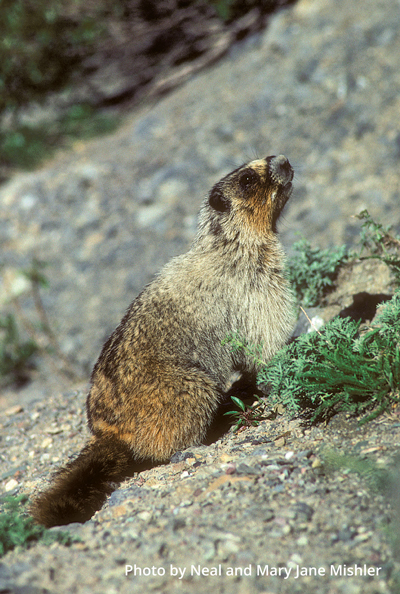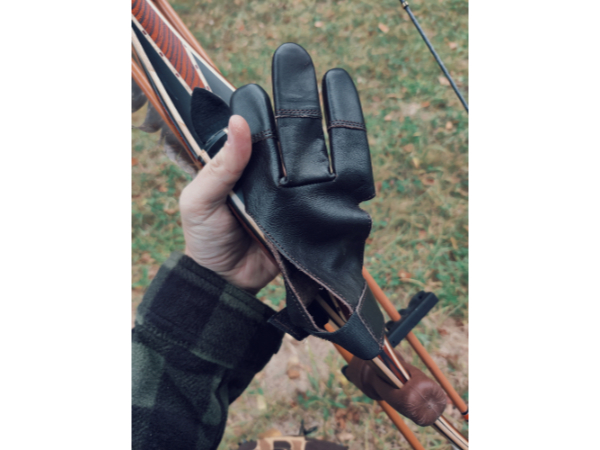Mosquito wings screamed a high-pitched buzz in my ear and I expected to feel the insect’s bite at any second. I was frozen in a crouched position, looking like a scientist’s drawing of the missing link between primitive apes and modern man. Indeed, I felt primitive, drenched in sweat and stalking my quarry with nothing but a longbow and pointed sticks. The knee-high grass swayed gently in the June breeze and an agitated bobolink flew overhead, singing its jumbled flight song. The scene seemed peaceful enough, but I was stuck. I wanted to straighten slightly, come to full draw, and pick a spot on the big boar’s chest, but I knew that I had to be patient and wait until the grizzled old male returned to all fours before I could relax and ease into shooting position.
I didn’t want to screw this up. I had spotted the old boy nearly 30 minutes earlier while glassing a hay field from the forest edge. He was about 150 yards out when I first saw him and I had managed to close the distance to 15 by crawling and using the field’s topography to hide my movements. Finally, just when I thought I couldn’t hold my stooped position any longer, he dropped down to resume feeding. Relieved, I eased down to my knees and nocked an arrow. After waiting a minute or so, I came to full draw and gave a soft whistle. When he stood, the broadhead-tipped arrow took him squarely in the chest, knocking him off his feet. I jumped up to determine if a second arrow would be necessary, but it wasn’t. The three-bladed Wensel Woodsman had done its job, killing the ground grizzly cleanly. What a rush! Given the adrenaline surging through my body, you’d think I was stalking an authentic grizzly on the Alaskan tundra, but no. It was just a woodchuck or, depending on where you live, a groundhog, whistle pig, or ground grizzly. Regardless of what you call them, Mamota monax presents a great summer-time bowhunting challenge. In fact, it’s a quarry that might surprise you. Unlike the experience just described, many of my woodchuck hunting efforts produce nothing but sweat and bent arrows.
I collected my chuck and took a seat on the ground beside his freshly excavated burrow to enjoy a brief rest and take in the scenery. Handling the dead woodchuck reminded me of my early days as a wildlife biology student, when I studied the stomach contents of woodchucks collected from different habitats. Why in the world did I choose the lowly woodchuck for my first research project almost 20 years ago? Probably for many of the same reasons I’m still chasing them today. They are common, making them easy to study and hunt; they display interesting behaviors such as tree-climbing for favored foods and hibernating when the weather turns bitter; and most importantly, they are fun to chase with stick and string.
 Woodchucks have a wide geographic distribution, covering most of the eastern U.S. and much of Canada and westward to southeast Alaska. Their large range combined with their presence in a variety of habitats, including woodlots, farm fields, and prairies, makes them accessible to millions of bowhunters. They thrive in edge habitats such as fencerows, well-drained stream banks, and the union of forests and fields. Woodchucks feed on grasses, forbs, and fruits such as blackberries and apples. They are true hibernators, usually retreating to their underground burrows in fall and emerging in early spring just before their breeding season begins. Most states have liberal seasons for woodchucks, typically beginning in early summer and ending in fall.
Woodchucks have a wide geographic distribution, covering most of the eastern U.S. and much of Canada and westward to southeast Alaska. Their large range combined with their presence in a variety of habitats, including woodlots, farm fields, and prairies, makes them accessible to millions of bowhunters. They thrive in edge habitats such as fencerows, well-drained stream banks, and the union of forests and fields. Woodchucks feed on grasses, forbs, and fruits such as blackberries and apples. They are true hibernators, usually retreating to their underground burrows in fall and emerging in early spring just before their breeding season begins. Most states have liberal seasons for woodchucks, typically beginning in early summer and ending in fall.
Woodchucks provide great off-season practice for hunting big game. I think of them as the white-tailed deer of the rodent world. Like whitetails, you can hunt them by ambush, still-hunting, or spot and stalk, and their relatively keen sense of smell always dictates an upwind approach. Some of my favorite places to hunt woodchucks are pastures, hay fields, power-line cuts, and old apple orchards. Probably the most productive way to hunt them is to pattern their daily movements and wait near their burrows for them to emerge, usually in mid-morning or late afternoon. Active burrows can be located by looking for signs of recent excavation, such as fresh dirt piled in front of entrance holes. Most burrows have a main entrance with a “drop hole” nearby. The drop hole serves as a rapid escape route to evade predators. Still-hunting can also be productive, particularly along fencerows and in open woodlots.
My favorite strategy, however, is to spot and stalk. I use binoculars to scan large fields for feeding woodchucks and then stalk close for a shot. The key is to stay hidden and only move when the chuck is down feeding. This works best when the grass is somewhere between shin- and knee-high. If the grass is too short, the chuck’s vision won’t be obscured and you stand a good chance of being busted. If the grass is too tall, chucks are hard to find and it’s difficult to tell when they’ve stood up to scan for danger.
I glanced at my watch and realized it was time to move on. I was hunting in New York’s Finger Lakes National Forest, which sits high above Seneca Lake. My plan was to still-hunt the edge of a large woodlot to a pasture overlooking the lake, a great spot to take in the sunset and listen as the sounds of songbirds give way to the chorus of spring peepers and American toads. As I eased down the hill, I watched the rock-strewn forest edge for signs of movement, since this was the time of day when chucks would be coming out to feed on the lush grass and clover. As I neared the lower corner of the woodlot, a small chuck dashed for its drop hole on the forest edge. The little rodent must have seen or winded me.
My first instinct was to stop walking, but assuming the chuck wasn’t overly alarmed, I knew it would return soon. I needed to get into shooting range, but the wind wasn’t quite right, so I moved around to position myself on the downhill side of the chuck’s hiding place. I leaned against a huge old white oak to break my silhouette and waited. Overhead in one of the oak’s massive limbs, a gray squirrel flipped its tail up and down and barked to protest my presence. About ten minutes had passed and I was beginning to wonder if the little chuck would return when, as I was craning my neck to see the squirrel, the chuck emerged from its hole and stopped a mere 10 yards away: a chip shot, or so I thought. I watched in frustration as my arrow sailed harmlessly over the chuck’s head and skipped over the rocks. So much for picking a spot!
I retrieved my arrow and discovered that the broadhead had sustained some minor damage from the rocks. Oh well; nothing a little filing couldn’t fix. Woodchucks may be considered small game, but they’re tough critters. When hunting them, I like to use a sturdy, three-bladed broadhead, such as a Wensel Woodsman or Magnus Snuffer. If you use a two-bladed head, be sure to put some kind of collar behind it to reduce penetration. On marginal hits, it’s best to have the arrow remain in the animal to prevent it from escaping into its burrow. I prefer aluminum shafts to wood because aluminum tends to be slightly more durable, an important point when shooting at small targets in rocky terrain. I frequently find myself shooting from a kneeling position when hunting chucks, so I refer a short bow. My favorite is a 56” Thunderstick Mag, but any legal hunting weight bow will get the job done.
I slid my banged-up arrow into my bow quiver and continued downhill toward the pasture. I glassed the field until dusk, but just couldn’t find another chuck. It didn’t matter; I’d enjoyed a great afternoon and had a chuck for the oven. No, you didn’t read that wrong. Chucks are good eating once you get over their strong flavor and tough meat. I try to make good use of everything I kill and woodchucks are no exception. After skinning, quarter the body and boil the pieces for a few minutes. Then place the pieces in a baking bag with potatoes, carrots, celery, onion, some water, and spices to taste. Bake until the potatoes (and the woodchuck) are soft and tender. Baked woodchuck may not be venison, but it makes a gratifying meal nonetheless.
Retracing my steps to the truck, I saw several deer including a good buck as they made their way into the fields to feed. My mind automatically started calculating the days: July, August, September, October… more than 100 days until deer season.
Or perhaps more appropriately, only 100 days left to stalk ground grizzlies.
*****
Ron Rohrbaugh is the owner of an archery business, LifeCycle Gear. They make and sell traditional bows, built from only sustainably harvested, native North American woods. His book, A Traditional Bowhunter’s Path is available on his website and on Amazon. This was his first of many articles for Traditional Bowhunter, published in the Apr/May 2004 issue.







Leave A Comment